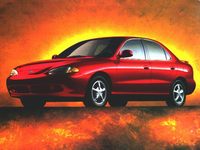New Car Review
SEE ALSO: Hyundai Buyer's Guide
1996 Hyundai Elantra GLS Wagon
by Carey Russ
In the ten years that Hyundai has been selling cars in this country, its fortunes have varied wildly. After a record-breaking success with its first offering, the Excel, in 1986, Hyundai fell on hard times as the market for inexpensive cars softened. Rather than abandoning U. S. sales, the company did its research and changed its automotive lineup to meet American expectations. The 1996 Elantra is a product of that attitude. Available in sedan or station wagon body styles, it is a small car that is anything but basic. With a new chassis, styling, and engine this year, it offers the buyer good fuel economy, unique styling, just about everything most people want as standard equipment, and all with very respectable price tag.
Elantra sedans and wagons are sold in two trim levels. The base Elantra is a well-equipped car; the GLS is very comprehensively outfitted for its size and price category. The station wagon has plenty of room for a small family or anyone else who can appreciate the economical, practical, extra-large-hatchback nature of a small wagon. I recently had an Elantra GLS wagon for a week. It was comfortable, with good fit and finish, plenty of interior space and adequate power for its mission in life. And the bottom line on the price sticker was considerably less than that of some competitors.
APPEARANCE: The Elantra is at the forefront of new Hyundai design, with bold, futuristic styling. Even the wagon is an eye-catcher. It's hard to make a station much more than a two-box functional design, but Hyundai's stylists have succeeded. The operative word outside is "round." At the front, a definite face made from the ovoid, multi-element headlights and low, oval air intake gives the car character. There is a prominent rounded bulge in the sloping hood that extends between the headlights. Body- colored front and rear bumper fascias are integrated into the bodywork, and the sides of the Elantra wagon are heavily sculpted. The passenger cabin has a steeply-raked windshield and rounded, slightly sloped rear window, and plenty of glass area. Trim around the side windows is the only chrome on the car. A rounded bulge in the station wagon's roof echoes that of the hood and adds styling interest. Matte black roof racks and swoopy silver plastic wheel covers add functional style.
COMFORT: The new Elantra is a considerable step up from the Hyundais of a few years ago in comfort and convenience. Almost every common feature is standard equipment on the GLS model. Power-operated windows, door locks, and mirrors, a full-length center console with covered storage, cargo area shade, and even thoughtful little details like separate driver and passenger dome lights and a shaded area in front of the rear-view mirror help make the GLS wagon a class act. The only major option on my test car was a combination package of air conditioner and cruise control. While pricey, the AC worked extremely well. Interior styling of the 1996 Hyundai Elantra GLS wagon repeats the oval motif of the exterior, with a flowing instrument panel and door inserts. Comfortable cloth-covered front bucket seats in front and a contoured bench in the rear make the Elantra wagon a good family car, roomy for its size. The driver's seat is 6-way adjustable, and the rear seat folds down with a 60/40 split. The tailgate is supported by hydraulic struts and the cargo floor is low for easy access.
SAFETY: The 1996 Elantra GLS wagon has dual airbags, four-wheel disc brakes, 5-mph bumpers, front and rear crush zones, and side-impact protection beams as standard equipment. Antilock brakes are available.
ROADABILITY: Improved chassis rigidity, increased wheelbase and track, a redesigned fully-independent suspension on subframes, and additional soundproofing add up to make the 1996 Elantra GLS wagon smoother and quieter than its predecessor and many competitors. The ride is on the firm side but comparable to most other cars in its class. Maneuverability is better than expected for a subcompact wagon. Good visibility adds to safety and passenger enjoyment.
PERFORMANCE: The 1996 Elantra uses Hyundai's new Beta engine. This dual overhead cam, 16 valve 1.8-liter unit produces 130 horsepower. More importantly for everyday driving, it makes nearly 90% of its peak torque of 122 lb-ft at engine speeds commonly used in city and highway traffic. It is designed for smooth, quiet, low-maintenance operation. The front wheels are driven through a 4-speed electronically-controlled automatic transmission. The GLS wagon has very good low speed performance and enough power to merge safely in highway traffic. The transmission shifts smoothly and quickly, and does not hunt around between gears on long, steep hills.
CONCLUSIONS: Hyundai has come a long way in the last decade. Once known for economy subcompacts bought strictly on price, it now has a small car that can compete successfully with anything in its class.
SPECIFICATIONS
1996 Hyundai Elantra GLS Station Wagon
Base Price $ 13,799
Price As Tested $ 15,250
Engine Type inline 4-cylinder, dual overhead cam, 16 valves
Engine Size 1.8 liters, 110 cu. in.
Horsepower 130 @ 6000
Torque (lb-ft) 122 @ 5000
Transmission 4-speed electronic automatic
Wheelbase / Length 100.4 in. / 175.2 in.
Curb Weight 2718 lbs.
Pounds Per Horsepower 21
Fuel Capacity 14.5 gal.
Fuel Requirement unleaded regular
Tires P195/60 R14 Michelin XGT
Brakes, front/rear vented disc / disc
Suspension, front/rear independent MacPherson strut /
independent multilink with coil springs
Drivetrain front engine, front-wheel drive
PERFORMANCE
EPA Fuel Economy - miles per gallon
city / highway / observed 22/31/26
0 to 60 mph 10.5 sec
1/4 mile (E.T.) 17.8 sec
Coefficient of Drag (cd) 0.33



